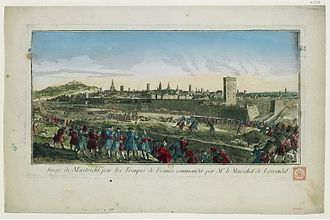Belagerung von Maastricht (1748)
| Belagerung von Maastricht | |||||||||||||||||
|---|---|---|---|---|---|---|---|---|---|---|---|---|---|---|---|---|---|
| Teil von: Österreichischer Erbfolgekrieg | |||||||||||||||||
 Belagerung von Maastricht 1748 |
|||||||||||||||||
| Datum | 15. April 1748 bis 7. Mai 1748 | ||||||||||||||||
| Ort | Maastricht | ||||||||||||||||
| Ausgang | Kapitulation der niederländisch-österreichischen Besatzung | ||||||||||||||||
|
|||||||||||||||||
Europäischer Kriegsschauplatz:
Mollwitz* – Chotusitz* – Simbach – Dettingen – Toulon – Pfaffenhofen – Tournai – Fontenoy – Hohenfriedberg** – Soor** – Hennersdorf** – Kesselsdorf** – Brüssel – Piacenza – Namur – Roucourt – Kap Finisterre 1 – Lauffeldt – Assietta – Bergen op Zoom – Kap Finisterre 2 – Maastricht
(*) Erster Schlesischer Krieg – (**) Zweiter Schlesischer Krieg
Indischer Kriegsschauplatz:
Erster Karnatischer Krieg
Amerikanischer Kriegsschauplatz:
War of Jenkins’ Ear – King George’s War
Die Belagerung von Maastricht fand von April bis Mai 1748 während des Österreichischen Erbfolgekrieges statt. Eine französische Armee unter dem Kommando des Maréchal général Moritz von Sachsen belagerte und eroberte die befestigte holländisch-lütticher Stadt während der letzten Monate des Feldzuges in den Niederlanden. Nach einer verhältnismäßig langen Belagerung musste sich die Garnison von Maastricht ergeben und erhielt freien Abzug mit allen militärischen Ehren. Auf französischer Seite fiel der Lieutenant général Anne-Louis de Thiard de Bissy.
Maastricht wurde mit dem Abschluss des Vertrages von Aachen bereits im Oktober desselben Jahres zurückgegeben.
Literatur
- Reed Browning: The War of the Austrian Succession. Alan Sutton Publishing, Stroud 1994, ISBN 978-0-7509-0578-7 (eingeschränkte Vorschau in der Google-Buchsuche).
- Gaston Bodart, Militär-historisches Kriegs-Lexikon (1618-1905),S. 213
- Oesterreichischer Erbfolge-Krieg 1740–1748, Band 9, S.721ff
License Information of Images on page#
| Image Description | Credit | Artist | License Name | File |
|---|---|---|---|---|
| ↑ Civil flag or Landesfarben of the Habsburg monarchy (1700-1806) ↑ Merchant ensign of the Habsburg monarchy (from 1730 to 1750) ↑ Flag of the Austrian Empire (1804-1867) ↑ Civil flag used in Cisleithania part of Austria-Hungary (1867-1918) House colours of the House of Habsburg | Eigenes Werk, basierend auf: The Flags & Arms of the Modern Era . | ThrashedParanoid and Peregrine981 . | Datei:Flag of the Habsburg Monarchy.svg | |
| Royal Standard, raised in the presence of the King of France (used as a state flag by the Kingdom of France under the absolute monarchy). Used from around 1638 to 1790 | Eigenes Werk, basierend auf: “ Pavillon royal de France. il est blanc semé de fleurs de lis d’or, chargé des armes de France, entouré des colliers des ordres de S. Michel & du S. Esprit, & deux anges pour support. ” — Encyclopédie, ou Dictionnaire raisonné des sciences, des arts et des métiers (1751). “ Pavillon Roïal de France. il est blanc, semé de fleurs de lis d'or, & chargé d'un Écusson des armes de France, entouré des Colliers des ordres de St Michel & du St Esprit. ” — La connoissance des pavillons ou bannieres que la plûpart des nations arborent en mer (1737) . A depiction of 'Pavillon Royal De France' is shown in the same book . the standard flying from a first rate Admiral's flagship (painted 1693) The standard flying from the Soleil-Royal at the Battle of Barleur (painted 1693 by Ludolf Bakhuizen) 'Pavillons de France' from 'Le Neptune françois, ou Atlas nouveau des cartes marines' (P. Mortier, 1700). Image of the 'Pavillon royal de France' from the 'Encyclopédie, ou Dictionnaire raisonné des sciences' (1751). White flag of France with the fleur-de-lis of the Bourbon kings, flanked by two angels. ( Flags through the ages and cross the world 1975 by Whitney Smith.) | Sodacan | Datei:Royal Standard of the King of France.svg | |
| View of Maastricht, the Netherlands, showing the attaques of the army of Louis XV of France on the city in 1748 during the War of the Austrian Succession. Print in the collection of the Bibliothèque nationale de France in Paris. | http://gallica.bnf.fr (website Bibliothèque nationale de France) | unknown cartographers, c.1750 | Datei:Siège de Maestricht, 1748, BNF.jpg | |
| Flagge der Republik der Sieben Vereinigten Provinzen . | Eigenes Werk, basierend auf: Prinsenvlag.svg | Dr. Feelgood | Datei:Statenvlag.svg |

